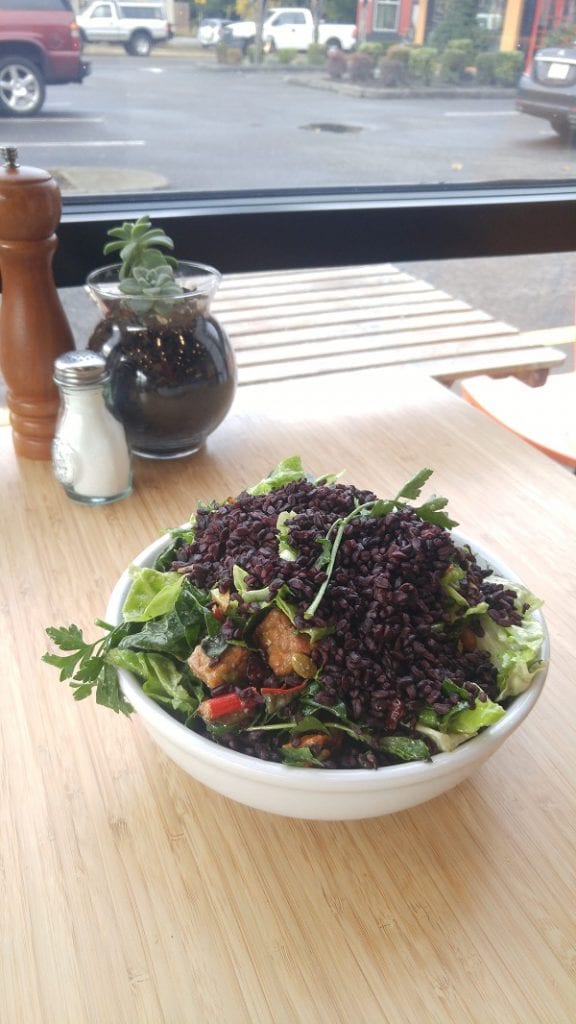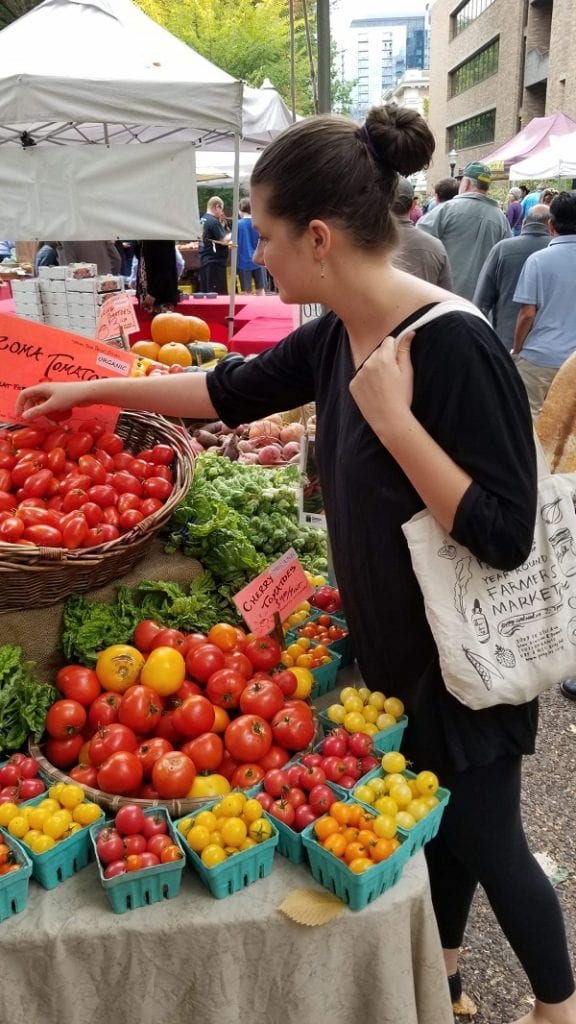With droughts becoming more and more frequent, it’s vital that we think about how we allocate the freshwater we have available. The earth’s surface is 70% water, but only 2.5% of that is freshwater that humanity can use for drinking or irrigation. We have discussed already the impact of fashion upon water consumption and the environment. Now we need to address the water footprint of food.
Agriculture is responsible for 80-90% of the water use in the U.S., so what we grow and eat impacts our water footprint a lot!
What is the “Water Footprint”?
A water footprint is how much water we use in preparing a product for consumption. It includes blue water, green water, and greywater.
- Blue Water: water taken from freshwater sources, typically used for irrigation;
- Green Water: water in the form of rain or snow;
- Grey Water: water used to dilute by-products to keep the environment safe;
When we talk about water footprints, we consider all uses of water from irrigation to the growing of food and to the processing of products to get a realistic idea of how much water we consume.
Understanding the Water Footprint of Food
In general, we usually talk about gallons of water per pound or ton of food. It’s important to remember, though that the nutritional value and calories from different foods vary. Therefore, some measurements might refer to gallons of water per calorie.
Eating a tomato with a water footprint of 13.2 gallons doesn’t mean you are actually consuming that much water though. That’s way more water than the size of the tomato! It merely refers to the total amount of blue, green, and greywater that was used in growing that tomato.
Our Water Footprint of Food is Hidden
When we go buy a snack at the store, there isn’t a tag attached to it telling us how much water was used in growing it. We wish it were that easy! That’s why we should all get a general understanding of what types of foods have a higher water footprint than others.
Many water footprint calculators exist online that have already done the work for you. The Waterfootprint.org even has a scroll-through gallery that breaks down everyday items into the types and amounts of water used!
Food Groups and Their Water Footprint

Let’s take a look at some general food groups to get an idea of how your water footprint can change depending on your diet.
Meat
Meat has the biggest water footprint across the food categories. But not all meats have the same water footprint. Beef tends to have the highest water footprint, and fish has the lowest (no freshwater needed if caught in the ocean!)
- Beef: 1,852 gallons/pound
- Lamb: 1,248 gallons/pound
- Pork: 718 gallons/pound
- Chicken: 518 gallons/pound
- Tofu (not technically meat but used as such): 334 gallons/pound
- Fish: 0 gallons/pound
Dairy
Animal by-products have a water footprint too, but not as much as meat usually. Butter does have a particularly high water footprint though as the milk is processed a few more times to become butter!
- Eggs: 63 gallons/egg
- Milk: 48 gallons/cup
- Butter: 665 gallons/pound
- Yogurt: 88 gallons/cup
- Cheese: 668 gallons/pound
Fruits and Veggies: How does produce stack up to meat?

Generally speaking, it’s safe to say that fruits and veggies usually have a lower water footprint than meat and animal by-products. Let’s see our favorite delights’ water footprints!
- Strawberries: 46 gallons/pound
- Broccoli: 38 gallons/pound
- Avocado: 262 gallons/pound
- Asparagus: 284 gallons/pound
There are some exceptions, however! Nuts require an unusually high amount of water to grow as well!
- Hazelnuts use 1,260 gallons/pound.
- Pistachios use 1,362 gallons/pound.
- Almonds use 1,929 gallons/pound.
The water footprint of food that might surprise you
Sadly, chocolate also has a really high water footprint! It takes 2,061 gallons of water to make a pound of chocolate. And although it’s unlikely you’ll eat a pound of chocolate in one sitting (as compared to a pound of beef), that’s still really high.
Vanilla extract takes the cake though at 15,156 gallons of water per pound! Thankfully we only use teaspoons at a time.
Why do animal products tend to have a higher water footprint than fruits and vegetables?

You may have noticed the trend that animal products generally have a higher water footprint compared to fruits and vegetables. That isn’t always the case (like the nuts example above), but in general, it’s a good rule of thumb. But why does meat need more water than plants?
Feeding the animals uses a lot of water
When you imagine how a piece of meat got to your table, you need to remember that not only did that animal drink water, but it ate plants that drank water too. Cows, for example, eat a lot of corn. Corn requires a lot of water to grow itself! To get meat, you need to grow a plant using water, and then give water to the animal too!
However, animals don’t need as much water as you think
The water footprint from animals comes mostly from the water required to grow the feed. For beef, 98% goes towards growing the feed, but the cow actually drinks only 1.1%.
And yet, sustainable farming can help reduce the water footprint
Because feed takes so much water to grow, sustainable farming practices can help reduce the water footprint or at least make it smaller. Factories that feed their cows crops grown in fields generally rely on irrigation water – a lot of blue water. Farmers that let their cows graze in fields can take advantage of the grass they grow using rainwater. So instead of using a lot of blue water taken from rivers or wells, farmers are using the green water coming straight from the sky!
Remember that the water footprint of a crop will vary by region and climate
In China, it takes 13,688 gallons of water to produce a ton of beef. In India, however, it takes 16,547 gallons. That’s 20% more water for the same amount of food! Farmers should take into account crops that are native to the environment and don’t require excessive irrigation. Given the variability in climates, though, water footprints will always be changing depending on the heat and humidity!
And also, that toxic waste from processing foods also pollutes water!
Greywater is required to “dilute” the toxic waste coming from food processing plants to make it safe to put into the water system again. Certain products need more greywater than others. It’s important to remember that many companies across the world still do not follow water pollution guidelines.
The food you are eating may be contributing to ocean pollution because of a company’s improperly disposed of toxic waste.
Although there is not a list of “ocean polluting” companies out there, remember that you can be a conscious consumer and research companies for their environmental practices.
So what foods should you eat?
Everybody’s diet, culture, environment, and resources are different. We’re not here to tell you to eat X, Y, and Z to achieve the lowest water footprint possible.
Knowledge is critical, though, and every consumer should understand the resources that go into the food they eat – from the carbon footprint to the water footprint.
What can we do to lower the water footprint of food we consume every day?
The answer below looks a bit crazy, but it isn’t!
Drink more water!
As counterproductive as it sounds if you want to save water, drink water. The old saying, “Save water; drink beer” doesn’t have any truth to it! Most drinks require much more water to grow the ingredients and bottle the flavor than drinking just straight water.
- Coffee: 66 gallons/cup
- Beer: 19 gallons/cup
- Tea: 7 gallons/cup
- Wine: 54 gallons/cup
- Orange Juice: 49 gallons/cup
Buy and Eat Fresh Foods – And Also Support Your Local Community

Food that is in-season and fresh will have a lower water footprint. Because produce will grow during the climates it likes best, it’s a good idea to purchase food when it’s in-season. Not only will it be fresher and taste better, but it also won’t typically require as much irrigation (i.e., green water) than if it was grown in an area where it doesn’t usually.
Farmer’s markets are amazing places to find fresh produce grown in your community. Many cities and states also have online resources and handy “food wheels” to help you figure out what is in-season.
Eating fresh food will also reduce the water footprint of food you and your family enjoy every day. Processed foods have higher prints than their fresh counterparts. Tomato sauce has a higher footprint than tomatoes alone, and potato chips use three times the water as compared to just new potatoes. Just think about your food choices when shopping at the grocery store and consider the alternatives you have.
What is Your Water Footprint of Food?
You now got a general idea of the water that is required to grow your meat, yogurt, oranges, tomatoes, and rice! When you’re at the grocery store, keep those statistics in mind, and make informed choices when it comes to your diet.
Do you know what is the water footprint of food you buy and eat every day? Can you give us more examples of edible items with low water footprints you consume and we would like to try as well? Use the comment section to voice your thoughts on the water footprint of food and the changes you made or are making right now to feed the gourmand in you but also protect the environment!
References
https://www.nationalgeographic.com/environment/freshwater/freshwater-crisis/
https://www.ers.usda.gov/topics/farm-practices-management/irrigation-water-use/background/
https://waterfootprint.org/en/resources/interactive-tools/product-gallery/
https://waterfootprint.org/en/water-footprint/product-water-footprint/water-footprint-crop-and-animal-products/
https://www.huffpost.com/entry/food-water-footprint_n_5952862
https://waterfootprint.org/media/downloads/Mekonnen-Hoekstra-2012-WaterFootprintFarmAnimalProducts.pdf